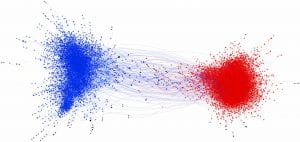Constructing our own intellectual ghettos
Throughout Trump’s presidency, political analysts have said there was never a time in American history where the country has been more divided since the Civil war.
While many would place the blame of this divide on the presidential incumbent, in “Constructing our own Intellectual Ghettos’ ‘, political journalist David Bauder discusses how that nationally televised news could be the culprit through extreme bias in reporting.
Bauder describes this issue through the scope of two independent political commentators Peggy Albrecht: a liberal freelance writer and comedian, and John Dearth: a Democrat turned conservative post-Reagan election, and current Trump supporter. As many Americans do in this day and age, both commentators turn to digital media to stay current. Albrecht watches MSNBC and browses liberal news sites whose topics focused on how Trump is an unfit leader, while Dearth watches Fox News and reads the Drudge report whose topics focus on attacks on Trump supporters.
Like many other politically- involved Americans, both Abrechts and Dearth try to investigate opposing viewpoints in order to be fully educated on the issues. However in this media age, it has become increasingly difficult as polarized news networks have used hyperbole and selective reporting to pursue their own political agenda, and over the years, Americans have played right into their hands, embracing themselves in media outlets that validate their political views and dismissing sources and people who do not. All the product of a two-decade struggle by major broadcasting companies to deliver balanced news, and incidentally overcorrected.
However, the Associative Press arranged a meeting between Albrecht and Dearth to hopefully shrink that divide. While they disagreed on some points they did find common ground certain policies and acknowledged that further conversation between parties would go a long way.
As I was reading this article I kept thinking about graph structures and how the connectivity graphs would look like in various points in American history; with the graph being virtually one component after the Revolution, to being more dispersed with still many moderates in the middle during the split of the Democratic and Republican party, to nearly complete network split in the brink of the Civil War, and a series of continuous building and splitting of ties until we reach modern-day as tow very dense and components with very few interconnected components and many local bridges.
Modern-day

